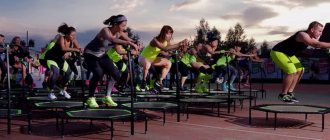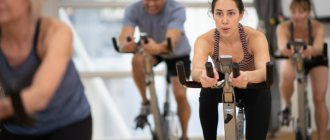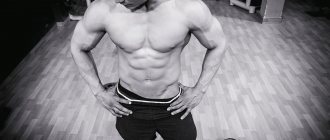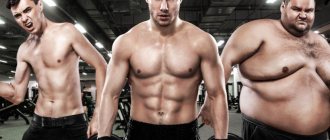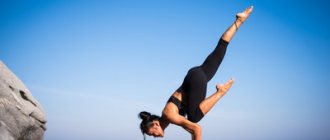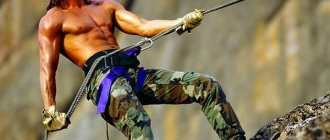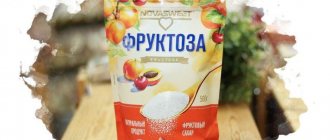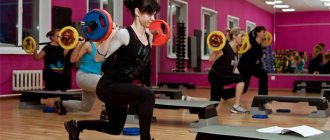In 2021, fitness clubs offer about 200 areas and training programs. Each lesson solves both individual problems and a complex of problems, including weight loss, strengthening the cardiovascular system, working out muscles, increasing joint mobility, developing endurance and generally improving health.
Despite the fact that fitness is not a professional sport, it is difficult for a person who knows little about physical activity to understand the intricacies of programs and exercise sets. But it will be easier to decide on the direction if you familiarize yourself in detail with the existing types of fitness. A wise choice will allow you to achieve the desired results, be it health, a slim figure, state of mind or emotions.
What types of training are there in fitness?
All types of fitness training are aimed at specific goals (stretching, building muscle mass, losing weight or strengthening the heart), include different types of loads (strength, aerobic, combined) and involve specific body systems.
Fitness programs with similar characteristics are conventionally grouped into areas. In particular, these are oriental practices, dance classes, strength or cardio training, mixed techniques and complexes more focused on stretching. To choose a suitable program for physical activity, it is better to get to know each type in more detail.
Eastern practices
The goal of training combined in this direction is the harmonious development and improvement of not only the body, but also the spirit. The techniques are usually based on smooth movements and static poses. Exercises work to develop coordination and balance, improve flexibility and agility, and increase muscle tone. The program also includes meditative and breathing practices.
During training, it is important to concentrate on the process and control the sensations in the body with your mind, since “wandering” thoughts will only interfere with achieving your goals. The result of such exercises will be not only a toned figure, elastic muscles, ligaments and a resilient body, but also improved emotional and mental health, and improved mood.
Yoga
One of the most popular styles of modern fitness, which has many subtypes, schools and trends. Based on traditional ancient Indian practices. Regardless of the direction, training is a set of physical and spiritual techniques aimed at the comprehensive development of the body. During the class, static poses are slowly performed in which you need to stay for some time. Particular attention is paid to proper breathing.
Asanas relieve pain in the spine and joints, tone the muscles of the whole body and generally have a beneficial effect on all systems of the body. Classes improve your psycho-emotional state and effectively combat stress, depression and insomnia. Yoga is accessible to people with any level of physical development and is especially suitable for those who are not ready for intense exercise and active sports movements. You can practice asanas at any age and at any weight.
Taiji (taichi)
The style is based on martial art (a type of wushu), invented by Chinese monks who observed the behavior of animals. As a result, the technique provides for measured, gradual, smooth techniques and gestures that slowly flow into each other. The practice involves proper breathing, proper mental attitude and concentration. They, like yoga, are aimed at simultaneous physical and spiritual development.
During classes, weights and additional equipment are often used, but this does not prevent us from recommending the equipment to older people and those who have no physical training at all. Such gymnastics restores joint mobility, strengthens the heart and blood vessels, improves blood circulation and teaches you to maintain mental balance. Tai Chi exercises relieve muscle and nervous tension, improve the mind and give restful sleep.
Pilates
Developed on the basis of tai chi and yoga, the Pilates system includes small amplitude dynamic movements aimed at working out (stretching and strengthening) every muscle of the body. It also provides for a clear interaction of exercises with the brain, but unlike some eastern practices, there is no static nature and “yogic” breathing in this direction. Regularly performing slow techniques makes muscles strong, straightens posture and helps with weight loss.
Fans of Pilates claim that this type of fitness can be done both in the gym and at home. And at any age and without a high level of physical fitness. But experts in the field and experienced La Salute trainers warn that, despite the safety of Pilates, classes should be started under the supervision of an instructor. This will eliminate the possibility of injury and will maximize the development of ligament elasticity, joint flexibility, strength and endurance.
Qigong
The smooth, continuous movements of Chinese ancient gymnastics are not aimed at specific parts of the body and muscles, but affect the entire body. The process of performing exercises requires concentration of thoughts and synchronization with breathing. Moreover, the latter in this technique can be different: hard, soft, abdominal and natural. The classes have a minimum of contraindications and are accessible to everyone in terms of difficulty level. But it is better to practice qigong with a certified master.
Kalaripayattu
The classes are based on Indian martial art, and the purpose of the training is physical and spiritual self-improvement. Self-defense techniques are diluted with gymnastic relaxation exercises and breathing practices. Kalaripayattu adherents promise that as a result of practicing:
- immunity will increase;
- your well-being will improve;
- stress levels will decrease;
- the figure will tighten;
- flexibility will develop;
- Laziness and apathy will disappear.
Budokon
A relatively new training program that has gained popularity among Hollywood stars and is actively promoted by the fitness industry. The classes combine various martial arts techniques, yoga asanas, breathing practices and meditation in a harmonious proportion. Training allows you to achieve excellent physical shape, develop self-knowledge and give peace of mind.
Dance group training
Such activities are often preferred by those who are bored with monotonous sports movements. The techniques are combinations of choreographic elements and basic steps that are performed to dynamic music. Training develops plasticity, increases flexibility, improves joint mobility and strengthens the heart muscle. In addition, dance fitness exercises actively burn calories, which as a result contributes to effective and fairly rapid weight loss.
Dance aerobics
The goal of such training is to strengthen muscle groups throughout the body, lose weight and relieve stress. The classes use various styles, such as hip-hop, funk, oriental and many others. Moreover, some dance programs have already been transformed into a separate form with their own varieties. For example, Zumba, whose workouts are accompanied by fiery Latin music and include movements of popular dances such as samba, mambo, flamenco and salsa.
Baylotherapy
This technique combines Latin and African dances, aerobic elements, Pilates, yoga and meditation. Accordingly, classes provide high performance and multidirectional effects on the body. In particular, this includes losing weight, developing muscles and strengthening the spine.
Strip plastic, cardio strip and half dance
Movements in such practices train plasticity, flexibility and femininity, as well as improve posture and promote weight loss. There are dynamic exercises, stretching, ballet choreography, and Latin. But all movements have a sexual connotation and are filled with non-vulgar and non-vulgar eroticism, which helps the fair sex to relax and begin to feel much more confident.
Pole Dance
Another technique with an erotic slant, but performed on a pole (pole). The movements are dominated by sports acrobatics and choreography. All elements are performed slowly, smoothly and require significant strength. Classes form a beautiful muscle profile, pump up the whole body and develop endurance. The exercises are suitable for both women and men.
Cardio training
This type of physical activity is widely represented in fitness. Such exercises are characterized by high duration, high number of repetitions and provide good results in burning fat and improving heart function. Many types use additional equipment: fitball balls, step pads or barefoot hemispheres.
Shaping
This type of load is nothing more than rhythmic gymnastics with a clear sequence of exercises. The workouts provide different levels of programs designed based on scientific evidence for nine body types. Shaping is aimed at women from 30 to 50 years old and is aimed at reducing weight and volume, building a toned figure and generally strengthening the muscles of the body.
Aerobics
An aerobics class is a classic cardio workout: simple gymnastics exercises are performed to rhythmic music that allows you to control the frequency of movements. Such fitness programs usually consist of leg swings, running in place, jumping, stretching, and push-ups, which tone muscles, strengthen blood vessels and promote weight loss.
Step aerobics
The essence of this technique is to perform sequences of steps using a special platform. Simple movements imitate going up and down stairs, accompanied by rhythmic music. A fairly intense workout perfectly tightens the muscles of the legs and buttocks, improves the figure and strengthens the ligaments and joints. Exercise prevents diseases of the musculoskeletal system and promotes recovery from injuries.
Cycle
Cycle is an intense workout on a special exercise bike, performed alternately while sitting in the saddle or standing on the pedals. In the process, the student imitates the passage of a real route over rough terrain, for which the trainer periodically changes the level of load. The training program is quite energetic, so it has some contraindications. But for those for whom such loads are acceptable, cycling helps to lose weight, strengthen muscles and generally bring the body into optimal physical condition.
Fitball and bosu
Aerobic exercises are performed in the first case on balls, and in the second - on a hemisphere, where they do ligaments similar to step steps. Training can be considered both as a separate type of fitness and as an addition to other programs. Exercises using such equipment develop muscles, increase endurance, flexibility and improve coordination of movements.
Water aerobics
This type of activity is suitable for people with numerous health problems: scoliosis, thrombosis, hernias, varicose veins and other pathologies. When performing exercises, water relieves stress from the spine and joints, helping the body effectively pump muscles, strengthen the heart, develop lungs and lose weight. It’s also great that you don’t have to know how to swim to attend these classes: most of the movements are done simply while standing in the water. Exercises in the pool are suitable for people of any age, body type, and level of physical fitness.
Power training
Strength training uses weights, machines and your own weight, which helps build muscle mass and increase endurance. Exercises in these styles of fitness loads are performed with a small number of repetitions, but with high intensity.
Tai-bo
Although the name of this type of fitness comes from the word “taekwondo,” the workouts are more like aerobics mixed with Muay Thai. Quite dynamic exercises are performed to rhythmic music and combine arm movements reminiscent of boxing punches, dance steps, jumps and swings. Some tasks require the use of weights. Such exercises deeply work the muscles of the legs, arms and abs, improve flexibility and reduce body fat.
Crossfit
CrossFit workouts are intense interval techniques that include elements of weightlifting, gymnastics, running, weight lifting, powerlifting, rowing and others. In this case, static and strength exercises are combined, any of which usually lasts 20 minutes. Programs allow you to increase endurance and create a beautiful, strong body. However, experts say there is a high risk of injury, so training on your own is not recommended.
Body Sculpt
Any session using the Body Sculpt technique takes place in an aerobic mode, lasts 50 minutes and uses dumbbells, body bars and shock absorbers throughout. Such training is aimed at developing strong muscles and creating a beautiful body contour. At the same time, the type of fitness is considered accessible even to beginners, since the weight used can vary, and the maximum weight reaches only 6 kg.
Bodypump
In this style, as in Body Sculpt, equipment is also used - a barbell that is suitable for the weight of a specific user. Moreover, during the exercise, each muscle is selected with its own weight. The group training itself takes place non-stop, and the complex includes different types of exercises that involve all muscle groups and are repeated several times. Working in this mode is classified as strength aerobic exercise, which not only strengthens muscles, but also helps reduce volume by burning subcutaneous fat.
Fitness for stretching
Stretching activities reduce tension in the muscles and improve their blood supply, develop joint mobility and reduce the risk of age-related changes. Exercise is considered an excellent prevention of stress-related injuries and a good way to relieve muscle spasms and pain. Stretching exercises improve the elasticity of ligaments, straighten posture and gait, and also have a positive effect on vascular health and relieve mental stress.
Stretching
The stretching program involves classic stretching of tendons and muscles. The exercise system increases the flexibility of the spine and the elasticity of the ligaments, and also allows you to improve motor activity even in adulthood. The main advantage of the complex is that it does not overload the heart, and stretching can be done even with diseases of the organ. There are several methods and types of stretching:
- Static. When performing the exercise at the peak of extension, a delay in the pose is made for 0.5-3 minutes.
- Dynamic. The complex consists of springing movements and combinations of exercises of varying speeds, during which the emphasis is placed on the moments of maximum extension.
- Passive. Training does not involve working independently, but with the help of pressure from a partner.
- Isolated. Perform stretching exercises only for a specific muscle.
- Isometric. In this stretching, relaxation and stretching alternate.
Stretching exercises are used not only as an independent type of fitness, but also as part of other training programs.
Callanetics
The callanetics health complex is based on simple static exercises from ballet and yoga, as well as some breathing practices. A training complex of 29 elements helps speed up metabolism, and at the same time engages all the muscles of the body (deep and inactive ones as well). At the same time, the effectiveness of 1 hour of callanetics training is compared with 7 hours of shaping training. The exercises form correct posture, a beautiful muscular corset and have no contraindications for diseases of the spine. The system is suitable for everyone.
Bodyflex
The author's technique involves performing stretching exercises on various muscle groups with simultaneous breathing techniques for holding inhalation. Such training saturates cells with oxygen, normalizes blood supply to tissues and increases metabolism. The processes help strengthen muscles, lose weight and work to tighten the skin. Physiologists are still debating the effectiveness of bodyflex in weight loss, but the benefits of the program as a whole are beyond doubt.
Mixed group cardio and strength training
Mixed fitness training intelligently combines aerobic and strength training. This simultaneously leads to strengthening of the heart and muscles, the formation of a sculpted body and a decrease in volume. Typically, such classes are carried out at a high pace with quick changes of exercises, so they are not always suitable for physically unprepared users.
Circuit Training
The name of the program translates as “circular training” and this fully conveys the essence of the lesson, during which cycles of exercises included in the circle are repeated. At the same time, cardio and strength training are alternated. In addition, each movement is performed for a certain time or number of times, and the complete passage of the designated part is completed with rest. The set and number of tasks are developed by the coach, taking into account the level of training of the group participants. But usually this is running in place, jumping, squats, push-ups, abs, crunches and plank variations.
Interval/HIIT
The principle of interval training is the alternation of cardio tasks and strength exercises of varying intensity, for which certain periods of time are allocated. Such techniques do not so much increase muscle mass as activate metabolism and allow you to quickly burn calories and subcutaneous fat. The lesson lasts only 30 minutes, but the exercises are performed almost without interruption. For example, 20 seconds of high-intensity technique alternate with 60 seconds of a calm pace, and this is repeated for half an hour. The technique is suitable for people with training.
Interesting! An example of a high-intensity HIIT workout is the Tabata technique. This lesson lasts only 4 minutes and is carried out strictly using a stopwatch. During the specified time, repeat the following cycle 8 times: 20 seconds of intense exercise and with maximum impact (running, jumping, push-ups, squats, lunges, pull-ups, etc.), and then 10 seconds of rest. Tabata is ideal for muscle growth and weight loss.
FT/Functional Training
The peculiarity and advantage of such classes is the ability to work out all muscle groups, including small, deep and stabilizer muscles. To do this, complex, from a biomechanical point of view, exercises are used, and for greater efficiency, sports equipment is used. Such trainings promote weight loss, strengthen muscles and form correct posture.
TRX
Intensive classes are carried out using hanging loops, when work is carried out with your own body weight. This unique exercise machine is equipped with inserts for arms/legs and is attached to the ceiling. With its help, strength, functional, aerobic and static exercises are performed, which allows you to comprehensively strengthen the body. Moreover, ordinary movements give maximum results due to the need to balance and maintain balance. Training brings the body into ideal condition and increases the body's endurance.
Important! This division is quite arbitrary, because some types of fitness have features of several directions. For example, strength exercises include stretching, and dance movements are often used as a warm-up. It is for this reason that different classifications can be seen in different sources. Examples of this are stretching, callanetics, crossfit, pilates and many others.
Main types of training
There is a basic classification according to which all training is divided into:
- Aerobic. This category consists of low-intensity exercises performed over a long period of time at an easy, measured pace. The main source of energy during aerobic training is oxygen, which is used to ensure motor activity of the muscles. Such classes are carried out for fat burning and maintaining a normal figure. Positively affect the functioning of the cardiovascular system. Types of aerobic training: running, basketball, cardio exercises, walking, swimming, aerobics, skiing, etc.
- Anaerobic. These are high-intensity exercises performed with maximum effort at high speed. Oxygen in this case does not enter into internal reactions. The body draws energy from other sources. Anaerobic training is relevant for building muscle mass. Main types: bodybuilding, training with dumbbells, sprinting, training on weight machines, etc.
Interesting fact. Mixed or complex training is also distinguished, including aerobic and anaerobic exercises. By combining two types of sports elements, it helps the body spend internal resources more efficiently - at the same time, the processes of fat burning and muscle building are launched.
New types of fitness
Those who prefer variety in sports, want to change the load, want to try a new direction or simply “be on trend” can consider the types of fitness training that have appeared relatively recently. Some of them have already been described above, in particular, Budokon, Bosu, dance aerobics, tai-bo, baylotherapy and TRX. Other popular types are presented below:
- Jumping fitness. The author's training program, which appeared only 20 years ago, can not be taken seriously. After all, the lesson is identical to the fun of children and teenagers - trampoline jumping. Nevertheless, such a workout is an excellent cardio exercise and allows you to effectively lose weight, tighten your body contours and tone your muscles.
The mini trampoline is equipped with a handle to maintain stability while jumping. The activity itself involves performing movements in “flight”, when the legs push off the surface. This activity is suitable for people of any gender, age and body type. Simple workouts will lift your spirits, work your muscles and improve your coordination.
- Kangoo jumps. Like the previous type of fitness, kangaroo training involves jumping. The class takes place in special shoes equipped with springs, which were invented by an orthopedic doctor about 50 years ago. But fitness programs using boots have appeared relatively recently, so the style is considered quite new. Now there are at least 5 directions: power, dance, boot camp, kick&punch and for children over 6 years old. Most of them develop strength and endurance, work the muscles of the legs, abs and buttocks with an extremely low load on the joints and spine. Also, with the help of kangaroo jumping, you can burn up to 1000 kcal in 1 hour of exercise.
- Terarobics. The program appeared a quarter of a century ago, but has only received development in the last 3 years. The classes are classified as recreational aerobics, but the complex includes stretching, dancing and strength gymnastics. Cardio training is carried out at a high pace, and shock absorbers (latex or rubber band with clamps for the limbs) are used as an additional load.
The complexity of the exercises and choreographic content of teraborics is accessible to all ages, and the level of load is adjusted individually using the length of the shock absorbers. Classes help you lose excess weight, train the strength of your arms and legs, give you vigor and improve your psycho-emotional state.
- Ki-bo. The technique is similar to the previously described type called “tai-bo”. But ki-bo does not use aerobic exercises, but elements of dance. Thus, this type of fitness is a combination of martial arts and choreography. This activity burns up to 800 kcal, which promotes rapid weight loss. Ki-bo training is a kind of shadow boxing. The movements of the arms and legs resemble blows that are carried out against an invisible enemy. The training program develops strength, flexibility, strengthens the heart and respiratory system, and works the muscles of the whole body. In addition, punching the air relieves negative emotions, stress and depression.
- Aerofitness. Such training is now at the peak of popularity. Here, exercises from yoga, callanetics and Pilates are performed in a suspended state, using bands or a hammock. Fitness training uses up to 90% of the body's muscles, stretches the spine, relieves stress on the joints and ensures blood flow to the brain. You can benefit and enjoy yoga in hammocks at the La Salute club. Training under the supervision of experienced instructors, competent individual programs, convenient schedule and comfortable conditions - all this will ensure safety and maximum effect from physical activity in the air. Regardless of age and weight.
- Body ballet. This type of fitness appeared about 15 years ago and is a lightweight version (without complex choreography) of classical ballet. The training program is supplemented with elements of aerobics, Pilates and yoga, and movements are performed mainly at the machine. Training takes place at a moderate pace, often accompanied by classical music. The exercises are aimed at strengthening and stretching the muscles of the buttocks and legs, creating a beautiful figure, improving posture and relieving stress. The technique eliminates pain and the possibility of injury. The program is ideal for those who are contraindicated for intense exercise, but want to improve their physical condition and correct their body shape.
- Rope skipping. The sport, known since ancient times, became a fitness trend relatively recently (in Russia about 10 years ago). The training involves performing tricks of varying complexity when jumping over a skipping rope or rope and includes elements of acrobatics and dance choreography (breaking, hip-hop, rock and roll and others).
Such a dynamic activity is not just intense cardio exercise, but also high-quality strength work. The movements involve almost all the muscles of the body and actively burn subcutaneous fat. In addition, learning dance routines trains memory, and jumping rope develops dexterity and teaches coordination.
Important! During high-intensity exercise, it is necessary to continuously monitor your heart rate. To do this, it is better to wear a special device on your wrist during class. It will notify you that your heart rate has exceeded the maximum permissible values.
Stretching
Stretching helps maintain flexibility. We often forget about this in our youth, when our muscles are toned. With age, there is a loss of flexibility in muscles and tendons. The muscles contract and do not function properly. This increases the risk of muscle spasms and pain, muscle damage, strains, joint pain, and makes everyday activities such as bending to tie shoelaces more difficult.
Stretching your muscles makes them more elastic and flexible, which increases your range of motion and reduces pain and the risk of injury.
Aim to do stretching exercises every day or at least three to four times a week.
Always warm up your muscles before stretching to avoid injury. Repeat simple movements such as marching in place and swinging your arms. This speeds up the flow of blood and oxygen to the muscles, making them more flexible to stretch.
Then do static stretches (hold the stretching position for up to 60 seconds) For example: while sitting, bend forward as far as possible, hold the position for 60 seconds.
Stretch the tendons behind your knees, thigh muscles, quadriceps, and muscles in your shoulders, neck, and lower back.
Avoid severe pain. This makes the muscle more rigid and counterproductive.
Example: One Knee Rotation
One Knee Rotation
Starting position: Lie on your back with your legs extended.
Movement: Relax your shoulders to the floor. Bend your left leg at the knee and place it on your right thigh just above your knee. Pull your stomach in, then grab your left knee with your right hand and gently pull it behind your body toward the right side down. Hold for 10 - 30 seconds. Return to the starting position and repeat on the other side.
Tips and tricks:
- Pull until there is gentle tension, not pain.
- Try to keep your shoulders on the floor.
- To increase the stretch, look in the opposite direction to your knee.
How to choose a direction for yourself
The existing variety of types and areas of fitness makes it easy to choose the appropriate activity. But before you make your final decision, you need to take into account several factors, the first of which is your health status. It is necessary to undergo an examination at a medical institution and consult with a doctor to take into account contraindications and eliminate the possibility of negative consequences for the body.
Further, it is advised to consider classes depending on your goals, for example:
- Swimming, treadmill running, exercise bike, bodyflex and oriental techniques will help support the heart, blood vessels and respiratory system;
- You can lose weight and achieve general strengthening of the body using programs with jumps and multidirectional steps;
- to create beautiful athletic figures and lose weight, you can choose aerobics, strength and mixed training;
- Cardio exercises combined with Pilates, as well as bodyflex, will help remove the belly;
- You can achieve weight loss in your lower extremities with interval training alternately with cardio or body ballet.
The choice of direction also depends on age:
- For girls and women aged 18–30 years old, options of varying complexity are suitable, since at this age you can cope with almost any load. To achieve effective results, it is recommended to alternate types of exercises: stretching, static and cycling.
- Women aged 30–40 years will benefit from strength training with equipment, water aerobics and yoga. These classes can be combined with exercises on simulators.
- After 40, they recommend, in particular, stretching fitness, cycling and oriental practices. But depending on the state of the body, options are possible (dance classes, fitball).
- In the postpartum period, low-impact training and dance programs should be considered, and strength and aerobic programs should be started only after 2 months of regular activity.
- Men can choose any physical exercise, alternating cardio with strength training. At the same time, split training is recommended for more advanced athletes, when certain days are allocated to work specific muscle groups.
And, of course, it is worth taking into account personal preferences and mood. For example, some people like monotonous, measured exercises, some will like active “explosive” workouts, and others will want to relax while performing oriental sets of exercises. When choosing, you need to pay attention even to the musical accompaniment.
Important! In different fitness clubs, the same directions do not always have the same content. Therefore, after studying the theory, it is important to communicate with the instructor, or better yet, attend a trial lesson. These measures will also allow you to select a program of the appropriate level of complexity.
Strength training what is it
Strength training is a type of physical activity that increases muscle mass and develops static muscle strength. Examples of strength exercises: barbell squats, bench presses, deadlifts, barbell holds.
The training process is built according to the following scheme: load – full recovery – load.
Strength training methods
The strength training method is a way to develop the muscular system by systematically increasing the weight load.
The basis of the training process is separate training. One day one muscle group (maximum two) is worked, another day another.
The principle of strength training is to “load” one muscle to failure with different exercises. Give her a few days to rest. Then repeat or increase the load. This training process provokes the growth of muscle tissue.
Let's consider the method of dividing training into parts using the example of split training.
Split is a type of strength training
Split is a program of separate strength training. The term “split” is derived from the English “split” - to split, divide.
The classic split training program consists of a three-day cycle. At each workout, basic exercises are performed first. Then insulating.
Rest between sets from 1 to 3 minutes or more. The athlete must have fully recovered strength before the next approach.
Here is a sample schedule for a week.
Monday – chest, shoulder girdle, triceps. Bench press – 4 sets of 6 reps. Reduction of arms in the butterfly simulator - one drop set. Bent over dumbbell press – 3 sets of 10 reps. Reverse dumbbell press – 3 sets of 10 reps.
Wednesday – muscles of the legs and abdomen. Barbell squats – 4x6. Leg curls on the machine – 3x8. Leg extension on the machine – 3x8. Leg raises, 4x30. Crunches 3x30.
Friday – back and biceps. Deadlift – 3x8. Pull-ups – 3x12. Bent-over barbell row – 3x10. Standing biceps curl – 4x8. Lifting dumbbells for biceps alternately - 4x12.
